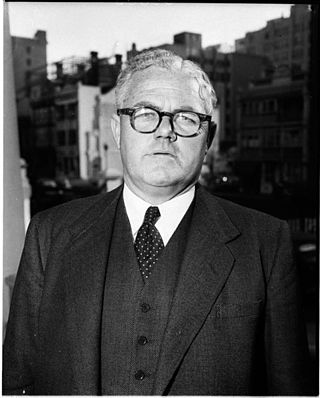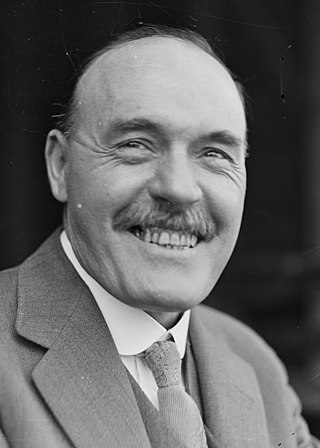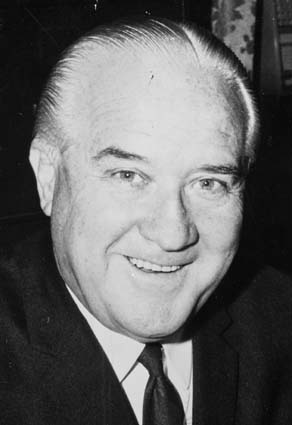Related Research Articles

John Joseph Cahill, also known as Joe Cahill or J. J. Cahill, was a long-serving New South Wales politician, railway worker, trade unionist and Labor Party Premier of New South Wales from 1952 to his death in 1959. Born the son of Irish migrants in Redfern, New South Wales, Cahill worked for the New South Wales Government Railways from the age of 16 before joining the Australian Labor Party. Being a prominent unionist organiser, including being dismissed for his role in the 1917 general strike, Cahill was eventually elected to the Parliament of New South Wales for St George in 1925.

Sir Eric Archibald Willis was an Australian politician, Cabinet Minister and the 34th Premier of New South Wales, serving from 23 January 1976 to 14 May 1976. Born in Murwillumbah in 1922, Willis was educated at Murwillumbah High School and the University of Sydney, where he obtained a Bachelor of Arts with double honours. Enlisting during World War II, Willis served on the homefront and later served in New Guinea and the Philippines. He continued to serve the Citizen Military Forces until 1958.

Lieutenant Colonel Sir Michael Frederick Bruxner was an Australian politician and soldier, serving for many years as leader of the Country Party in New South Wales. Born in the north of the state, Bruxner was educated at The Armidale School and started studies at University of Sydney but later dropped out to take up employment as a grazier and station agent in Tenterfield. After serving in the Citizen Military Forces from 1911, Bruxner enlisted into the Australian Light Horse upon the outbreak of the First World War in 1914. Serving with distinction in Gallipoli, Egypt and Palestine, he was promoted to lieutenant colonel and awarded the Distinguished Service Order.
× Members of the New South Wales Legislative Assembly who served in the 37th parliament held their seats from 1953 to 1956. They were elected at the 1953 state election, and at by-elections. The Speaker was Bill Lamb.
George Weir was an Australian barrister and politician who was a member of the New South Wales Legislative Assembly from 1941 to 1953.
Members of the New South Wales Legislative Assembly who served in the 25th parliament of New South Wales held their seats from 1920 to 1922. They were elected at the 1920 state election on 20 March 1920. The Speaker was Daniel Levy with the exception of 13–20 December 1921 when he was replaced by Simon Hickey.

Philip Henry (Pat) Morton was an Australian businessman and politician. Born in Lismore in Northern New South Wales to a prominent political family and educated at Lismore High School, Morton left school at fourteen to be employed in a legal firm, before branching out into various businesses. Moving to Sydney, Morton first entered politics in 1944 as an Alderman on Mosman Municipal Council, rising to be Mayor in 1946. Morton then entered the New South Wales Legislative Assembly on 3 May 1947, representing the Electoral district of Mosman for the Liberal Party.

Sir Vernon Haddon Treatt was an Australian lawyer, soldier, Rhodes Scholar and politician. Born in Singleton, New South Wales and educated at Shore School, Treatt interrupted his studies at the University of Sydney to enlist at the outbreak of the First World War. Serving in the Royal Australian Artillery, Treatt served in France and was awarded the Military Medal. Upon returning to Australia he was awarded a Rhodes scholarship and further educated at New College, Oxford.

The 1925 New South Wales state election was held on 30 May 1925. This election was for all of the 90 seats in the 27th New South Wales Legislative Assembly and was conducted in multiple-member constituencies using the Hare Clark single transferable vote. The 26th parliament of New South Wales was dissolved on 18 April 1925 by the Governor, Sir Dudley de Chair, on the advice of the Premier Sir George Fuller.
Heathcote Clifford Mallam was an Australian politician and a member of the New South Wales Legislative Assembly between 1953 and 1968 and between 1971 and 1981. He was a member of the Labor Party (ALP).
Francis Patrick (Frank) Connors was an Australian politician and trade unionist. He served as a member of the Labor Party in the New South Wales Legislative Assembly from 1930 to 1932, representing the electorate of Dulwich Hill.

The 1968 New South Wales state election was held on 24 February 1968. It was conducted in single member constituencies with compulsory preferential voting and was held on boundaries created at a 1966 redistribution. The election was for all of the 94 seats in the Legislative Assembly. The Liberal Party, led by Premier Robert Askin, in Coalition with the Country Party of Deputy Premier Charles Cutler, was elected for a second term—the first time that a non-Labor government had been reelected since before World War II.
Sydney, an electoral district of the Legislative Assembly in the Australian state of New South Wales, has had two incarnations, the first from 1920 to 1927 as a five-member electorate, the second from 2007 to the present as a single-member electorate.
Patrick Joseph Minahan, was an Irish-born Australian politician.
Dulwich Hill, an electoral district of the Legislative Assembly in the Australian state of New South Wales had two incarnations, from 1913 until 1920 and from 1927 until 1968.
Eastern Suburbs, an electoral district of the Legislative Assembly in the Australian state of New South Wales was created in 1920 and abolished in 1927.
The 1907 New South Wales state election involved 90 electoral districts returning one member each. The election was conducted on the basis of a simple majority or first-past-the-post voting system.
Sturt, an electoral district of the Legislative Assembly in the Australian state of New South Wales, had two incarnations, from 1889 until 1968 and from 1971 until 1981.
Redfern, an electoral district of the Legislative Assembly in the Australian state of New South Wales, has had two incarnations, the first from 1880 to 1920, the second from 1927 to 1968.
Surry Hills, an electoral district of the Legislative Assembly in the Australian state of New South Wales had two incarnations, from 1904 until 1920 and from 1927 until 1930.
References
- ↑ "Mr George Weir (1903-1956)". Former members of the Parliament of New South Wales . Retrieved 1 May 2019.
- ↑ "Mr Heathcote Clifford Mallam (1909–2006)". Former members of the Parliament of New South Wales . Retrieved 6 May 2019.
- 1 2 Green, Antony. "1953 Dulwich Hill by-election". New South Wales Election Results 1856-2007. Parliament of New South Wales . Retrieved 1 September 2020.
- ↑ "Dulwich Hill by-election". The Sydney Morning Herald . 20 June 1953. p. 3. Retrieved 1 September 2020– via Trove.